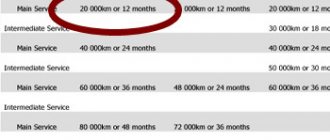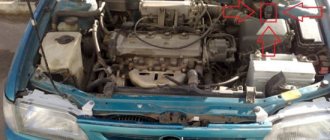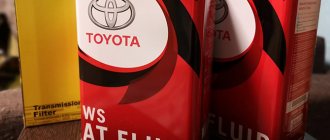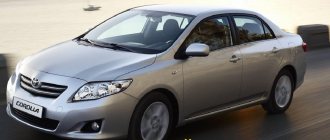What should be the tire pressure for a Toyota Corolla?
Toyota Corolla is one of the most popular cars not only from Toyota, but throughout the entire automotive world. This car became a real bestseller and sold between 13 and 17 million units, depending on the count. The car is famous for its quality and price. Toyota has proven that a good car with the same performance and design can cost relatively little money.
Corolla represents the C-class of cars, which are small-sized and subcompact city cars. Today it is available with several engine options:
- DOHC, 16-valve Dual VVT-i, 4-cylinder, in-line / 1.33-liter gasoline with a power of 99 hp. on a 6-speed manual transmission;
- DOHC, 16-valve Dual VVT-i, 4-cylinder, in-line / 1.6-liter gasoline with a power of 120 hp. on a 6-speed manual transmission;
- DOHC, 16-valve Dual VVT-i, 4-cylinder, in-line / 1.6-liter gasoline with a power of 120 hp. with variator;
- DOHC, 16-valve Dual VVT-i, 4-cylinder, in-line / 1.8-liter gasoline with a power of 140 hp. with variator;
- Diesel from 155 hp up to 175 hp with an engine capacity of 2.0 liters./li>
The smooth ride of the car is ensured by the McPherson front independent suspension and rear beam from Toyota developers. The car sits on 15-inch wheels, which maintain a tire pressure of 1.8 to 2.2 bar for a smooth and safe ride.
Tire pressure is one of the most important components of a good and safe ride. Normal pressure should be maintained in the range of 1.7 to 1.8 bar in the front tires and 1.9-2.0 bar in the rear. These data are valid when the car is loaded with three people and a maximum of 170 kilograms of cargo at speeds up to 160 km. When driving faster, you should increase the tire pressure by 0.1 bar for every additional 10 km/h.
With a maximum load of Corolla for 4 people and approximately 600 kg of cargo, it is necessary to maintain pressure at 2.0-2.1 bar in the front tires and 2.2-2.3 bar in the rear.
This data is valid for the above versions of a car with a manual transmission; if your Corolla has an automatic transmission or a CVT, it is worth increasing the tire pressure by 0.2 bar from the standard parameters. This is due to the fact that both gearboxes place a large load on the front suspension.
Advice: if it is important for you to keep the suspension in good condition, fuel economy is significant and gentle handling is important, increase the tire pressure by 0.3 bar from the standard parameters recommended above.
The problem of a sudden decrease in tire pressure may indicate problems with the wheel as a whole or damage to the wheel from a nail or a piece of glass. The first problem occurs when the spool is faulty, the second when the wheel is punctured by a sharp object without remaining in the body of the tire.
In order to avoid problems with the suspension in the future and to avoid accidents with skidding or poor braking distance due to tires, you should check the pressure every 2-4 weeks. If a visual inspection shows a reduced pressure level, inspect the wheel; if no breaks are found, pump it up. If the tire pressure is below the established norm of 1.7 bar after a few hours, go to a service station.
Note: on cold tires the pressure is slightly lower by about 0.1-0.2 bar, when driving the pressure increases by 0.3-0.4 bar due to faster air circulation, based on this you should not panic when the pressure is not warm tires will be 0.1-0.15 bar lower.
It is worth understanding that correct, good tire pressure affects fuel consumption and your safety, because driving on tires with reduced pressure is several times more difficult and dangerous, because the braking distance and acceleration speed are reduced.
(3 ratings, average 3.33 out of 5)
Source
What are the dangers of driving on improperly inflated tires?
Many novice motorists have the misconception that an overinflated tire is preferable to an underinflated one. An argument for this can be that on hypercars the tire pressure is usually higher than normal. In fact, any pressure deviation from normal values has an equally negative effect on the tires. Thus, with insufficient pressure, the contact area of the tread with the road surface increases, which causes greater wear at the edges.
Insufficient tire pressure is indicated by:
- increased fuel consumption by 10-20%;
- cornering with great effort;
- the car moves to the side when driving at speeds above 50 km/h.
When the normal pressure value is exceeded, the tread has a smaller contact area with the blade, therefore increased wear is observed in the center. Tire pressure that is too high is indicated by:
- loss of control when cornering;
- car jumps at speeds above 60 km/h (if the wheel hits a pothole or runs over a rock, the tire may be damaged);
- suspension operation in overloaded mode;
- increased noise in the cabin.
When the vehicle is at maximum load, do not over-inflate the wheels. Some car enthusiasts do this, mistakenly believing that the load needs to be compensated by pumping.
TOYOTA()
TOYOTA. , .
:
, .
| TOYOTA | ||||||||
| Auris (E150) 07-12 | ||||||||
| 1.4 VVT-i (71 kW), 1.3 (73 kW) 08, 1.4 D-4D (66 kW) | 195/65 R15 91 H | 2.4 | 2.2 | 2.7 | 2.5 | |||
| 205/55 R16 91 V | 2.4 | 2.2 | 2.7 | 2.5 | ||||
| 225/45 R17 91 W | 2.4 | 2.2 | 2.7 | 2.5 | ||||
| 225/40 R18 92 Y | 2.4 | 2.2 | 2.7 | 2.5 | ||||
| 1.6 (91 kW), 2.0 D-4D (93 kW), 1.6 (97 kW) 09 | 205/55 R16 91 V | 2.4 | 2.2 | 2.7 | 2.5 | |||
| 225/45 R17 91 W | 2.4 | 2.2 | 2.7 | 2.5 | ||||
| 225/40 R18 92 Y | 2.4 | 2.2 | 2.7 | 2.5 | ||||
| 2.2 D-CAT (130 kW) | 225/45 R17 91 W | 2.4 | 2.2 | 2.7 | 2.5 | |||
| 225/40 R18 92 Y | 2.4 | 2.2 | 2.7 | 2.5 | ||||
| Auris (E180) 13 | ||||||||
| 1.3 (73 kW), 1.4 D-4D (66 kW) | 195/65 R15 91 H | 2.6 | 2.6 | 2.6 | 2.6 | |||
| 205/55 R16 91 V | 2.6 | 2.6 | 2.6 | 2.6 | ||||
| 215/45 R17 91 V | 2.6 | 2.6 | 2.6 | 2.6 | ||||
| 1.6 (97 kW), 2.0 D-4D (91 kW) | 205/55 R16 91 V | 2.6 | 2.6 | 2.6 | 2.6 | |||
| 215/45 R17 91 V | 2.6 | 2.6 | 2.6 | 2.6 | ||||
| 1.8 Hybrid (100 kW) | 195/65 R15 91 H | 2.6 | 2.6 | 2.6 | 2.6 | |||
| 205/55 R16 91 V | 2.6 | 2.6 | 2.6 | 2.6 | ||||
| Avensis (T25) 03-08 | ||||||||
| 1.6 VTT-i (81 kW), 1.8 VTT-i (95 kW) | 195/65 R15 91 V | 2.3 | 2.4 | 2.4 | 2.6 | |||
| 205/55 R16 91 V | 2.3 | 2.4 | 2.4 | 2.6 | ||||
| 215/50 R17 91 V | 2.3 | 2.4 | 2.4 | 2.6 | ||||
| 215/45 R17 87 V | 2.3 | 2.4 | 2.4 | 2.6 | ||||
| 225/40 R18 88 V | 2.3 | 2.4 | 2.4 | 2.6 | ||||
| 2.0 VTT-i (108 kW), 2.4 VVT-i (120 kW) | 205/55 R16 91 V | 2.3 | 2.4 | 2.4 | 2.6 | |||
| 215/50 R17 91 V | 2.3 | 2.4 | 2.4 | 2.6 | ||||
| 215/45 R17 87 V | 2.3 | 2.4 | 2.4 | 2.6 | ||||
| 225/40 R18 88 V | 2.3 | 2.4 | 2.4 | 2.6 | ||||
| 2.0 D-4D (85 kW), 2.2 D-CAT (130 kW) | 205/55 R16 91 V | 2.3 | 2.4 | 2.4 | 2.6 | |||
| 215/50 R17 91 V | 2.3 | 2.4 | 2.4 | 2.6 | ||||
| 215/45 R17 87 W | 2.3 | 2.4 | 2.4 | 2.6 | ||||
| 225/40 R18 88 W | 2.3 | 2.4 | 2.4 | 2.6 | ||||
| Avensis (T27) 09-15 | ||||||||
| 1.6 (97 kW) | 205/60 R16 92 V | 2.7 | 2.5 | 2.7 | 2.5 | |||
| 215/55 R17 94 W | 2.8 | 2.7 | 2.8 | 2.7 | ||||
| 1.8 (108 kW), 2.0 (112 kW), 2.0 D-4D (93 kW) | 205/60 R16 92 V | 2.7 | 2.5 | 2.7 | 2.5 | |||
| 215/55 R17 94 W | 2.8 | 2.7 | 2.8 | 2.7 | ||||
| 225/45 R18 95 W | 3.1 | 2.7 | 3.1 | 2.7 | ||||
| 2.2 D-4D (110 kW), 2.2 D-CAT (130 kW) | 215/55 R17 94 W | 2.8 | 2.7 | 2.8 | 2.7 | |||
| 225/45 R18 95 W | 3.1 | 2.7 | 3.1 | 2.7 | ||||
| Avensis Combi (T25) 03-08 | ||||||||
| 1.8 VVT-i (95 kW) | 195/65 R15 91 V | 2.3 | 2.4 | 2.4 | 2.6 | |||
| 205/55 R16 91 V | 2.3 | 2.4 | 2.4 | 2.6 | ||||
| 215/45 R17 87 V | 2.3 | 2.4 | 2.4 | 2.6 | ||||
| 2.0 VVT-i (108 kW), 2.4 VVT-i (120 kW) | 205/55 R16 91 V | 2.3 | 2.4 | 2.4 | 2.6 | |||
| 215/45 R17 87 V | 2.3 | 2.4 | 2.4 | 2.6 | ||||
| 2.0 D-4D (85 kW), 2.2 D-CAT (130 kW) | 205/55 R16 91 V | 2.3 | 2.4 | 2.4 | 2.6 | |||
| 215/45 R17 87 V | 2.3 | 2.4 | 2.4 | 2.6 | ||||
| Avensis Combi (T27) 09-15 | ||||||||
| 1.6 (97 kW) | 215/45 R17 87 V | 2.3 | 2.4 | 2.4 | 2.6 | |||
| 205/60 R16 92 V | 2.7 | 2.5 | 2.7 | 2.5 | ||||
| 215/55 R17 94 W | 2.8 | 2.7 | 2.8 | 2.7 | ||||
| 1.8 (108 kW), 2.0 (112 kW), 2.0 D-4D (93 kW) | 205/60 R16 92 V | 2.7 | 2.5 | 2.7 | 2.5 | |||
| 215/55 R17 94 W | 2.8 | 2.7 | 2.8 | 2.7 | ||||
| 225/45 R18 95 W | 3.1 | 2.7 | 3.1 | 2.7 | ||||
| 2.2 D-4D (110 kW), 2.2 D-CAT (130 kW) | 215/55 R17 94 W | 2.8 | 2.7 | 2.8 | 2.7 | |||
| 225/45 R18 95 W | 3.1 | 2.7 | 3.1 | 2.7 | ||||
| Avensis Verso (M2) 01 | ||||||||
| 2.0 VVT-i (110 kW) | 205/65 R15 94 H | 2.3 | 2.3 | 2.3 | 2.3 | |||
| 215/60 R15 94 H | 2.3 | 2.3 | 2.3 | 2.3 | ||||
| 225/60 R15 96 H | 2.3 | 2.3 | 2.3 | 2.3 | ||||
| 2.0 D-4D (85 kW) | 205/65 R15 94 H | 2.3 | 2.3 | 2.3 | 2.3 | |||
| 215/60 R15 94 H | 2.3 | 2.3 | 2.3 | 2.3 | ||||
| 225/60 R15 96 H | 2.3 | 2.3 | 2.3 | 2.3 | ||||
| Aygo 05/09-14 | ||||||||
| 1.0 (50 kW) | 155/65 R14 75 T | 2.2 | 2.2 | 2.3 | 2.3 | |||
| 1.4 D (50 kW) | 155/65 R14 75 T | 2.4 | 2.2 | 2.4 | 2.2 | |||
| Aygo 14 | ||||||||
| 1.0 (51 kW) | 165/65 R14 79 T | 2.3 | 2.3 | 2.3 | 2.3 | |||
| 165/60 R15 77 H | 2.3 | 2.3 | 2.3 | 2.3 | ||||
| Corolla 14 | ||||||||
| 1.3 (73 kW), 1.4 D-4D (66 kW) | 205/55 R16 91 H | 2.3 | 2.3 | 2.6 | 2.6 | |||
| 1.6 (97 kW) | 205/55 R16 91 V | 2.3 | 2.3 | 2.6 | 2.6 | |||
| Corolla Combi (E12) 02-09 | ||||||||
| 1.4 C (71 kW) | 175/70 R14 84 H | 2.4 | 2.2 | 2.6 | 2.6 | |||
| 195/60 R15 88 H | 2.4 | 2.2 | 2.5 | 2.5 | ||||
| 195/55 R16 87 H | 2.4 | 2.2 | 2.5 | 2.5 | ||||
| 1.6 (81 kW) | 195/60 R15 88 H | 2.4 | 2.2 | 2.5 | 2.5 | |||
| 195/55 R16 87 H | 2.4 | 2.2 | 2.5 | 2.5 | ||||
| 2.0 D-4D (66 kW) | 195/60 R15 88 H | 2.4 | 2.2 | 2.5 | 2.5 | |||
| 195/55 R16 87 H | 2.4 | 2.2 | 2.5 | 2.5 | ||||
| Corolla Verso 02/04-09 | ||||||||
| 1.6 16V (81 kW) | 185/70 R14 88 H | 2.4 | 2.2 | 2.6 | 2.6 | |||
| 195/60 R15 88 H | 2.4 | 2.2 | 2.6 | 2.6 | ||||
| 1.8 16V (99 kW) | 185/70 R14 88 H | 2.4 | 2.2 | 2.6 | 2.6 | |||
| 195/60 R15 88 H | 2.4 | 2.2 | 2.6 | 2.6 | ||||
| 1.8 VVT-i (95 kW) 04 | 205/55 R16 91 V | 2.4 | 2.2 | 2.6 | 2.8 | |||
| 215/50 R17 91 V | 2.4 | 2.4 | 2.6 | 2.8 | ||||
| 225/45 R17 91 V | 2.4 | 2.4 | 2.6 | 2.8 | ||||
| 225/40 R18 92 V | 2.4 | 2.4 | 2.6 | 2.8 | ||||
| 2.0 D-4D (66 kW) | 185/70 R14 88 T | 2.4 | 2.2 | 2.6 | 2.6 | |||
| 195/60 R15 88 H | 2.4 | 2.2 | 2.6 | 2.6 | ||||
| 2.0 D-4D (85 kW) 04 | 195/60 R15 88 H | 2.4 | 2.2 | 2.6 | 2.6 | |||
| 205/55 R16 91 V | 2.6 | 2.4 | 2.6 | 2.8 | ||||
| 225/45 R17 91 V | 2.6 | 2.4 | 2.6 | 2.8 | ||||
| 225/40 R18 92 V | 2.6 | 2.4 | 2.6 | 2.8 | ||||
| GT 86 13 | ||||||||
| 2.0 (147 kW) | 215/45 R17 91 W | 2.4 | 2.4 | 2.4 | 2.4 | |||
| 225/40 R18 92 W | 2.4 | 2.4 | 2.4 | 2.4 | ||||
| Hilux 06/06-14 | ||||||||
| 2.5 D-4D (88 kW) 06, | 285/50 R20 116 V | 2.6 | 2.6 | 2.6 | 2.9 | |||
| 3.0 D-4D (126 kW) 06 | 255/70 R15 108 T | 2.2 | 2.3 | 2.4 | 2.8 | |||
| 255/65 R16 109 T | 2.2 | 2.3 | 2.4 | 2.8 | ||||
| 255/60 R17 106 T | 2.2 | 2.3 | 2.4 | 2.8 | ||||
| IQ 09 | ||||||||
| 1.0 (50 kW), 1.4 D (66 kW) | 175/65 R15 84 T | 2.4 | 2.3 | 2.4 | 2.3 | |||
| 175/60 R16 82 T | 2.4 | 2.3 | 2.4 | 2.3 | ||||
| Land Cruiser (J 12) 03/07-09 | ||||||||
| 4.0 V6 (183 kW) | 265/65 R17 112 H | 2.6 | 2.6 | 2.6 | 2.9 | |||
| 3.0 D-4D (120 kW), 3.0 D-4D (127 kW) | 225/70 R17 108 T | 2.6 | 2.6 | 2.6 | 2.9 | |||
| 265/65 R17 112 H | 2.6 | 2.6 | 2.6 | 2.9 | ||||
| Land Cruiser (J 15) 10 | ||||||||
| 4.0 V6 (207 kW), 3.0 D-4D (127 kW) | 245/70 R17 110 T | 2.6 | 2.6 | 2.6 | 2.9 | |||
| 265/65 R17 112 T | 2.6 | 2.6 | 2.6 | 2.9 | ||||
| 265/60 R18 110 H | 2.6 | 2.6 | 2.6 | 2.9 | ||||
| Land Cruiser V8 (J20) 08 | ||||||||
| 4.7 V8 (212 kW), 4.5 V8 D-4D (210 kW) | 285/60 R18 116 V | 2.6 | 2.6 | 2.6 | 2.9 | |||
| 285/50 R20 116 V | 2.6 | 2.6 | 2.6 | 2.9 | ||||
| Prius 01/03/06 | ||||||||
| 1.5 16V Hybrid (53 kW) | 175/65 R14 82 T | 2.2 | 2.2 | 2.2 | 2.2 | |||
| 1.5 Hybrid (57 kW) 06 | 195/55 R16 87 V | 2.4 | 2.3 | 2.6 | 2.5 | |||
| RAV-4 (XA3) 06 | ||||||||
| 2.0 VVT-i (112 kW), 2.2 D-4D (100 kW), 2.2 D-CAT (130 kW) | 225/65 R17 102 H | 2.2 | 2.2 | 2.2 | 2.4 | |||
| 235/55 R18 100 H | 2.2 | 2.2 | 2.2 | 2.4 | ||||
| RAV4 13 | ||||||||
| 2.0 (111 kW), 2.0 D-4D (91 kW) | 225/65 R17 102 H | 2.2 | 2.2 | 2.2 | 2.2 | |||
| 235/55 R18 100 H | 2.2 | 2.2 | 2.2 | 2.2 | ||||
| 2.2 D-4D (110 kW) | 235/55 R18 100 H | 2.2 | 2.2 | 2.2 | 2.2 | |||
| Urban Cruiser 09 | ||||||||
| 1.3 VVT-I Town (74 kW), 1.4 D-4D Trek (4×4) (66 kW) | 195/60 R16 89 T | 2.5 | 2.5 | 2.5 | 2.5 | |||
| Verso (AR2) 09/13 | ||||||||
| 1.6 (97 kW), 1.8 (108 kW) | 205/60 R16 92 V | 2.4 | 2.3 | 2.7 | 2.6 | |||
| 215/55 R17 94 W | 2.4 | 2.3 | 2.7 | 2.6 | ||||
| 2.0 D-4D (91 kW), 2.2 D-4D (110 kW) | 215/55 R17 94 W | 2.4 | 2.3 | 2.7 | 2.6 | |||
| 2.2 D-4D (130 kW) | 215/55 R17 94 W | 2.4 | 2.3 | 2.7 | 2.6 | |||
| Yaris (XP13) 11 | ||||||||
| 1.0 (51 kW), 1.3 (73 kW), 1.5 Hybrid (55 kW), 1.4 D-4D (66 kW) | 175/65 R15 84 H | 2.3 | 2.2 | 2.5 | 2.4 | |||
| 195/50 R16 84 H | 2.3 | 2.2 | 2.5 | 2.4 | ||||
| Yaris (XP9) 06-11 | ||||||||
| 1.0 (51 kW), 1.3 (64 kW), 1.4 D-4D (66 kW), 1.3 (74 kW) | 165/70 R14 81 T | 2.2 | 2.2 | 2.3 | 2.3 | |||
| 185/60 R15 84 T | 2.2 | 2.2 | 2.3 | 2.3 | ||||
| 1.8 TS (98 kW) | 235/45 R17 94 W | 2.4 | 2.2 | 2.5 | 2.3 | |||
What does it affect?
Optimal air filling of rubber affects:
- Toyota's smooth ride;
- fuel consumption;
- reduction of braking distance;
- acceleration speed;
- safety of the driver and passengers.
The humidity of the pumped air also affects. Friction increases the temperature and increases the amount of water vapor if the air was pumped at high humidity. In this case, nitrogen is suitable for inflating tires. The following information is for avid racing enthusiasts.
Winter tire pressure
Hi all!
Already moved it to spikes. But what pressure is needed at certain temperatures in winter?
If -10 is one thing, but if -25, what pressure would you recommend?
Now I pump all 4 at 2.2 bar
Old timer
The same pressure is needed. It’s just that as it gets colder, the current pressure will drop, so you’ll have to pump it up. And then lower it when it gets warmer. At -40, you can see with the naked eye that the tires are flat.
Sold. The mileage was 323. I didn’t change the fluid in the varico.
Regular
When the temperature changes by 8-10 degrees, the pressure changes by 0.1 atm. Therefore, if you have 2.2 atm pumped at 0 degrees, then at -25 it will be somewhere around 1.9 atm. Well, once every 20 days you can check your blood pressure. It falls on its own.
When to check
Experts recommend regularly checking your tires for air. This is done once a month. The first step is to do a visual inspection. If the wheel has sagged, then pump it up after checking for punctures or a faulty spool.
When the pressure drops 60 minutes or less after pumping. If the car owner cannot see any visual defects in the wheel, it is recommended to take the car to a service center.
Steps of the pumping procedure:
- Stop the car.
- Remove the cap from the spool.
- Insert the hose.
- Turn on the compressor or cylinder with pure oxygen.
- When the barometer on the cylinder reducer shows the required pressure, tighten the valve.
This easy procedure is done at home.











